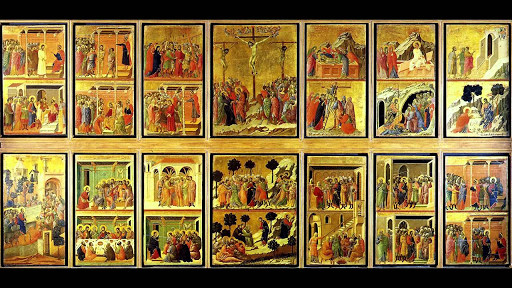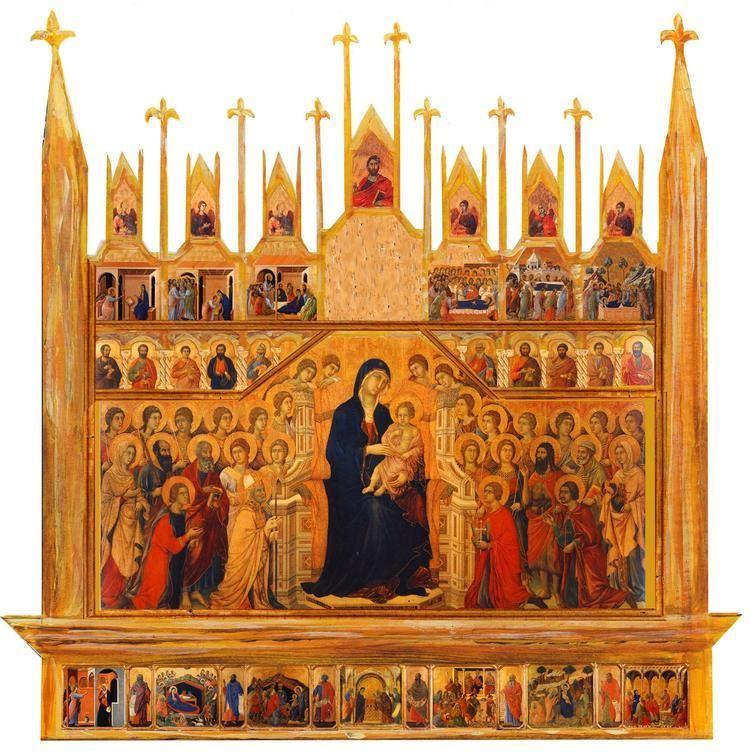Year 1308–1311 Dimensions 2.13 m x 3.96 m Period Byzantine art Media Tempera, Gold | Artist Duccio Created 1308–1311 | |
 | ||
Similar Duccio artwork, Tempera | ||
The Maestà, or Maestà of Duccio is an altarpiece composed of many individual paintings commissioned by the city of Siena in 1308 from the artist Duccio di Buoninsegna. The front panels make up a large enthroned Madonna and Child with saints and angels, and a predella of the Childhood of Christ with prophets. The reverse has the rest of a combined cycle of the Life of the Virgin and the Life of Christ in a total of forty-three small scenes; several panels are now dispersed or lost. The base of the panel has an inscription that reads (in translation): "Holy Mother of God, be thou the cause of peace for Siena and life to Duccio because he painted thee thus." Though it took a generation for its effect truly to be felt, Duccio's Maestà set Italian painting on a course leading away from the hieratic representations of Byzantine art towards more direct presentations of reality.
Contents

History

The painting was installed in the cathedral of Siena on 9 June 1311. One person who witnessed this event wrote:

And on that day when it was brought into the cathedral, all workshops remained closed, and the bishop commanded a great host of devoted priests and monks to file past in solemn procession. This was accompanied by all the high officers of the Commune and by all the people; all honorable citizens of Siena surrounded said panel with candles held in their hands, and women and children followed humbly behind. They accompanied the panel amidst the glorious pealing of bells after a solemn procession on the Piazza del Campo into the very cathedral; and all this out of reverence for the costly panel… The poor received many alms, and we prayed to the Holy Mother of God, our patron saint, that she might in her infinite mercy preserve this our city of Siena from every misfortune, traitor or enemy.

Besides the Virgin Mary and the Baby Jesus, saints depicted in the painting include John the Evangelist (to the left of the throne); Saint Paul; Catherine of Alexandria; John the Baptist (to the right of the throne); Saint Peter; and Saint Agnes. In the foreground are Siena’s various patron saints: Saint Ansanus; Saint Sabinus; Saint Crescentius; and Saint Victor.
Creating this altarpiece assembled from many wood panels bonded together before painting was an arduous undertaking. The work was not only large, the central panel was 7 by 13 feet, but it had to be painted on both sides since it could be seen from all directions when installed on the main altar at the centre of the sanctuary.
The altarpiece remained in place until 1711, when it was dismantled in order to distribute the pieces between two altars. The five-meter high construction was dismantled and sawn up, and the paintings damaged in the process. Partial restoration took place in 1956. The dismantling also led to pieces going astray, either being sold, or simply unaccounted for. Extant remains of the altarpiece not at Siena are divided among several other museums.
Stylistic Analysis
Christ's followers, Joseph and John, remove him from the cross while Nicodemus removes nails from his feet. The Virgin Mary looks into his closed eyes while Mary Magdalene holds his arm, and you can see the painful expression in everyone’s eyes as they tend to the dead Christ. The background has the same gold texture as in the "Crucifixion" and the cross that held Christ has blood running onto the ground, increasing the sense of realism in the scene. This panel aroused the emotions of its audiences and the story helped to symbolize the birth of Christianity.
Immediately following the "Deposition," is the depiction of Christ as he is prepared for burial, surrounded by his mourning followers. His mother leans in close to him and kisses him one last time and Mary Magdalene throws hers arms towards the sky in anguish. The background retains the gold setting of the "Deposition" and "Crucifixion," and the mountains in the background are similar to the mountains portrayed in previous and subsequent panels. These mountains lead the viewer’s eye to Mary who is accompanying him, and then to Christ’s face. This scene also elicits an intense emotional response from its viewers and you can see the close connection that the burial party has to Christ, and especially to the Virgin Mary.
